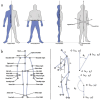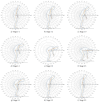Evaluating functional ability in older adults' object retrieval behavior from kitchen furniture using OpenPose and REBA
- PMID: 39462006
- PMCID: PMC11513087
- DOI: 10.1038/s41598-024-75470-6
Evaluating functional ability in older adults' object retrieval behavior from kitchen furniture using OpenPose and REBA
Abstract
The purpose of this study is to evaluate, through analysis, the ability of older persons to retrieve items from kitchen cabinets. To achieve this goal, data were collected from 128 valid questionnaires and supplemented with field research and user interviews. The study revealed that the elderly's behavior in retrieving items from kitchen spaces is characterized by both high frequency and difficulty. For this experiment, a total of 42 participants, comprising 21 males and 21 females from the self-care elderly population in the Yangtze River Delta region, were recruited. Two different experimental settings were arranged: one with kitchen utensils arranged in a straight line and another with a purpose-made chest of drawers with varying heights. Video recordings using the Logitech C930C were utilized to capture the gestures and behaviors of the elderly while retrieving objects from the kitchen cupboards (cabinets). By employing a combination of the OpenPose model and the Rapid Entire Body Assessment (REBA) method, which involves calculating human posture angles, REBA scores, and determining the risk level of Work-Related Musculoskeletal Disorders (WMSDs), a risk assessment framework for manual operations associated with WMSDs was developed. Using the angle data acquired from the user operation experiment as parameters, a gradient model of the elderly user's operational capability was established. The findings indicated a significant impact of neck, trunk, and knee movements on the subjects (P < 0.001). The participants were able to distinguish between different levels of exertion, categorizing movements as 'easy', 'moderate,' or 'strenuous.' These results form the basis for a comfort gradient model for leaning over and retrieving items. Given the prevalent conditions of bone and joint degeneration and osteoporosis among the elderly population, it is evident that they face challenges when accessing items in the kitchen. Therefore, investigating the elderly's execution abilities during the retrieval process becomes crucial. Understanding how different cabinet heights impact the joint angles of the elderly can be instrumental in optimizing cabinet designs for elderly users, thereby reducing their physical exertion in the kitchen and enhancing their comfort levels. This research holds significant value in improving the quality of life for the elderly population at home and fostering the advancement of elderly-friendly design principles.
Keywords: Aging-friendly design of cabinets; Behavioural ability to pick up objects; Openpose technology; REBA assessment method; The elderly.
© 2024. The Author(s).
Conflict of interest statement
The authors declare no competing interests.
Figures









Similar articles
-
Ergonomic suitability of kitchen furniture regarding height accessibility.Coll Antropol. 2015 Mar;39(1):185-91. Coll Antropol. 2015. PMID: 26040088
-
Effect of different postures and loads on joint motion and muscle activity in older adults during overhead retrieval.Front Physiol. 2024 Jan 18;14:1303577. doi: 10.3389/fphys.2023.1303577. eCollection 2023. Front Physiol. 2024. PMID: 38304288 Free PMC article.
-
An evaluation model for interactive gaming furniture design based on parent-child behavior.PLoS One. 2024 Jun 7;19(6):e0302713. doi: 10.1371/journal.pone.0302713. eCollection 2024. PLoS One. 2024. PMID: 38848424 Free PMC article.
-
The Sit & Stand chair. A revolutionary advance in adaptive seating systems.J Long Term Eff Med Implants. 2004;14(6):535-43. doi: 10.1615/jlongtermeffmedimplants.v14.i6.80. J Long Term Eff Med Implants. 2004. PMID: 15698379 Review.
-
Impact of summer programmes on the outcomes of disadvantaged or 'at risk' young people: A systematic review.Campbell Syst Rev. 2024 Jun 13;20(2):e1406. doi: 10.1002/cl2.1406. eCollection 2024 Jun. Campbell Syst Rev. 2024. PMID: 38873396 Free PMC article. Review.
Cited by
-
Preparation of Tea Tree Essential Oil-Chitosan Microcapsules and Its Effect on the Properties of Water-Based Coating.Polymers (Basel). 2025 Mar 22;17(7):849. doi: 10.3390/polym17070849. Polymers (Basel). 2025. PMID: 40219240 Free PMC article.
References
-
- Yeap, B. B. Toward healthy aging: A clinical trial builds on mechanistic insights. The journals of gerontology. Ser. A Biol. Sci. Med. Sci.78, 73–74. 10.1093/gerona/glac200 (2023). - PubMed
-
- Yu, Y. Healthy ageing in urban China: Governing the ageing population. Geogr. J.187, 28–38. 10.1111/geoj.12372 (2021).
-
- Xiao, D. C. & Chung, W. Interior design of aging housing based on smart home system of IOT sensor. J. Sens.10.1155/2023/9281248 (2023).
MeSH terms
Grants and funding
- 20220602/International Cooperation Joint Laboratory for Production, Education, Research, and Application of Ecological Health Care on Home Furnishing
- 20220602/International Cooperation Joint Laboratory for Production, Education, Research, and Application of Ecological Health Care on Home Furnishing
- 20220602/International Cooperation Joint Laboratory for Production, Education, Research, and Application of Ecological Health Care on Home Furnishing
LinkOut - more resources
Full Text Sources

